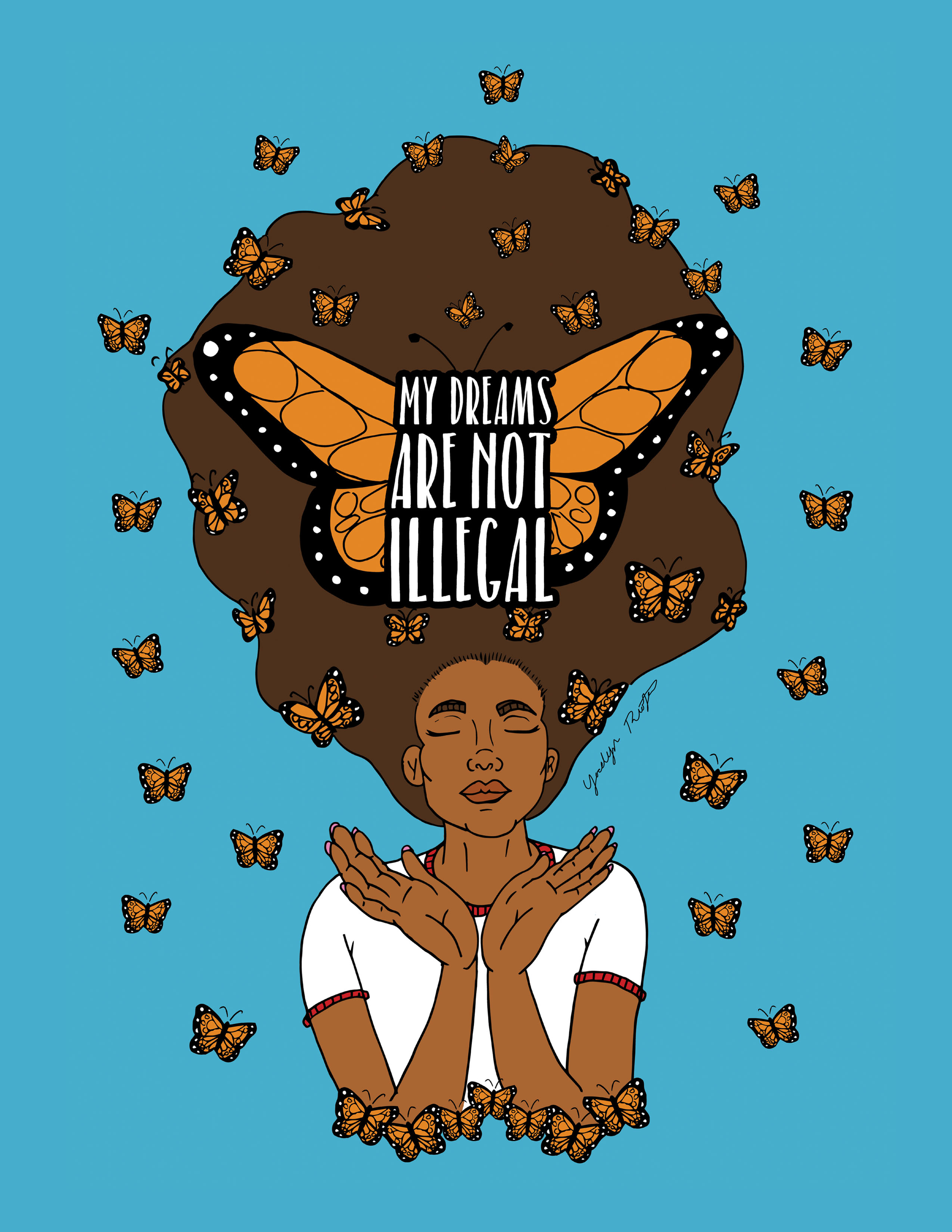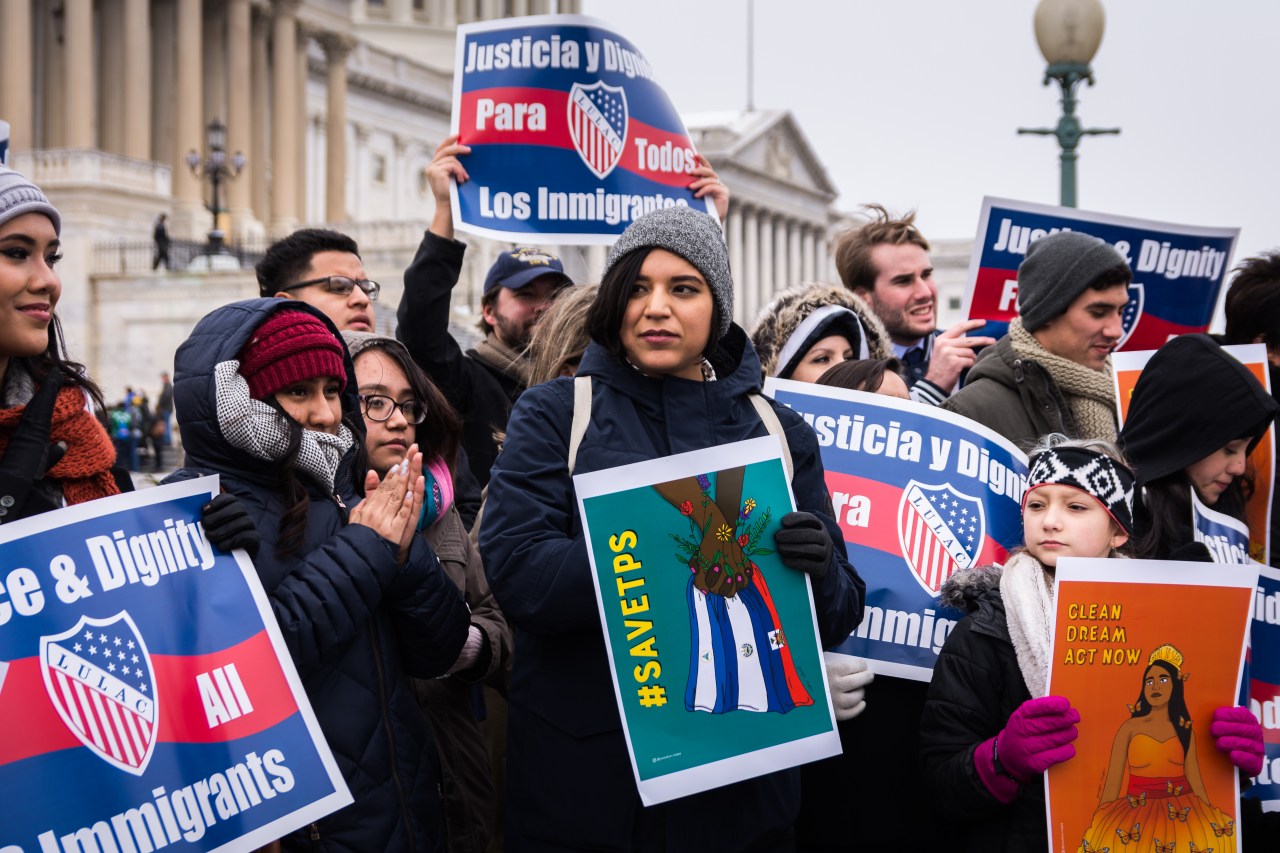From the steps of the Texas Capitol to the second annual Women’s March in Washington DC, the work of artist Yocelyn Riojas has made appearances at protests across the country. Her art represents the plight of undocumented immigrants, particularly Temporary Protected Status (TPS) holders and Deferred Action for Childhood Arrival (DACA) recipients. In one of her posters, an Afro-Latina woman is set against a bright blue backdrop adorned with monarch butterflies in her hair. Between the wings of the largest butterfly, the poster reads, “My dreams are not illegal.” Through her art, she has equipped the resistance with imagery as powerful as their stories.

While the Texas-based artist began her career studying animation, it was the lack of representation of brown women like her that prompted her to illustrate her own culture.
“Growing up, I saw very little of me in the media,” Riojas tells me. “I’ve been seeking to fill that void to give other Latinas a voice to connect to let them that brown is powerful and to remind them to always stay chingona.”
Though she grew up not seeing many women like her in the movies and television shows she watched, she was raised in the predominantly Latino border town of Eagle Pass. But after moving to Dallas to pursue her undergraduate degree, she felt more isolated and unsure of who she was.
“I have the opportunity to freely live in this country without the fear of DACA expiring and wondering what I would do next.”
“I never had to had to question my identity, because I grew up around people that looked like me my whole adolescent life,” Riojas says. “Going to the big city, I started noticing less people I could connect to.”
Within her field, the experience had her questioning everything. “I started wondering, ‘Am I here because I’m a token for diversity?’” Riojas says.
As she began questioning her purpose as an artist, she turned toward her own culture for inspiration – the vibrant colors of Mexican architecture, long-held traditions like Dia de Muertos, and the religious iconography deeply ingrained into the Mexican-American experience. But after the 2016 election, everything changed.
Rather than solely focusing on representation and women’s empowerment, she turned toward activism, hearing from friends from school and back home who showed her the reality and uncertainty of being a recipient of DACA.

“I have the opportunity to freely live in this country without the fear of DACA expiring and wondering what I would do next,” Riojas adds. “I learned to recognize the privilege I had as a naturalized citizen. From there, I had to figure out what could I do in order to help and for me, it was through art.”
Riojas, who didn’t see art pieces that spoke to their struggle, began using her talents at Texas protests. Last July after Latino activist group Jolt Texas organized a quinceañera protest against Senate Bill 4 – a bill that aimed to dismantle sanctuary cities and make life more unstable for the immigrant community – Riojas was moved to create a poster depicting a woman in a bright blue dress with matching flowers and a white sash that read “No SB4.”
After sharing the artwork with the activist group, Riojas began collaborating with Jolt, leading its “Make Art” committee, which allows her to find creative ways to resist and raise awareness for issues affecting the Latinx community.
With Jolt, Riojas has led the design on a sculpture that will be revealed at the steps of the Texas Capitol in late February, just before DACA is set to expire. (A federal judge blocked the Trump Administration’s plan to end the program while a lawsuit is still underway, but immigration groups are still cognizant of the original March 5 cut off date.) While the design will remain under wraps until then, Jolt executive director Cristina Tzintzún said it will pay homage to the more than 124,000 young people that make Texas the second-largest DREAMer population in the country.
“Oftentimes our culture is appropriated without giving our community the full power and respect that we deserve,” Tzintzún tells Remezcla. “This piece honors our community, while also challenging the way we’re treated and speaks to the role that immigration plays in making Texas what it is.”
Though she’s become a notable artivist in Texas, Riojas is also making a mark around the country. Anyone who follows the immigrant rights movement online has likely come across Riojas’ colorful work. Offline, her artivism has taken her to places like Washington DC, because she’s not drawing up the signs activist hold, she’s protesting alongside them, too.
“It’s important to have allies and voices outside the movement,” Riojas said. “But when you’re out there in the trenches alongside everyone, you need someone that knows what you’re experiencing. You need a voice you can understand.”







